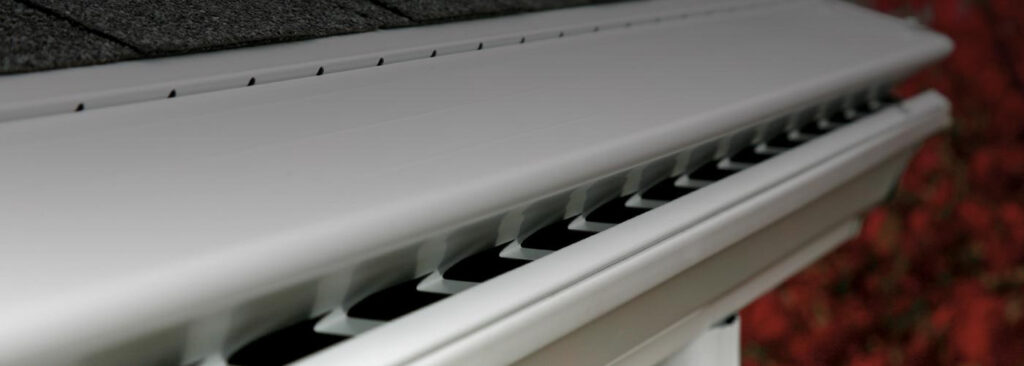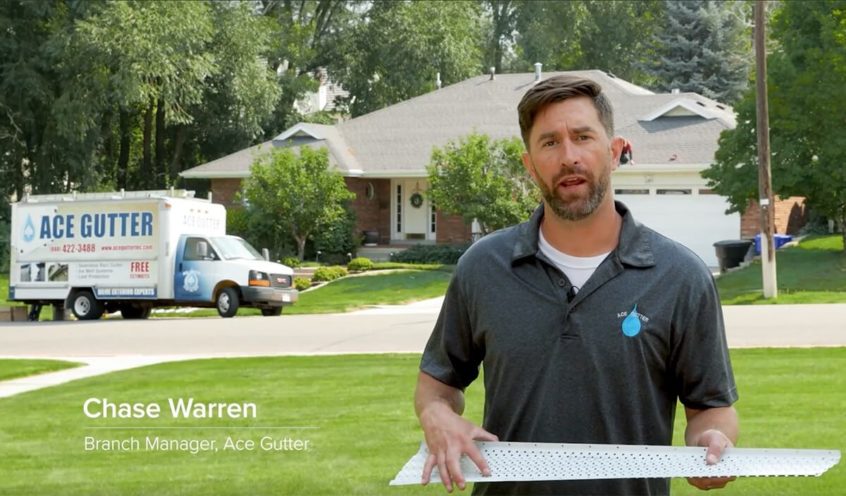While gutter leaf guards are crucial to your roofing system, cleaning them can be tedious and time-consuming. Probably the last thing you want is to spend your weekends perched on a ladder, scooping leaves out of your downspouts.
But gutter maintenance is one of those necessary chores you can’t put off. Clogged gutters can pave the way for a world of problems, including water damage, ice dams, and even cracks in the roof.
That said, gutter leaf guards can significantly reduce the number of times you have to clean roof gutters. They can cover your gutters and keep twigs, branches, and animal droppings from backing them up. Additionally, they prevent rodents and insects from making a nest out of your gutters.
But which type of gutter guard works best?
Let’s find out.
6 Types of Gutter Leaf Guards You Should Know About
Contrary to popular belief, there’s more than one type of gutter guard system in the market, each with its unique features and benefits. Let’s see what they are.
1. Foam Gutter Guards
As the name suggests, this gutter leaf guard is a piece of foam that fits into your gutters. Usually made from polyether or polyurethane, their primary purpose is to block out debris while still letting water pass through.
One of the biggest advantages of foam leaf gutter guards is that they are relatively inexpensive and easy to install. So, if you’re planning to DIY your gutter guard installation, this might be the choice for you.
But foam isn’t a flawless gutter guard material. For starters, it can mold quickly and may require frequent replacements. Moreover, it is unsuitable for high-precipitation areas because heavy rains can quickly saturate the foam, causing the gutters to overflow.
2. Bottle-Brush Gutter Guards
Brush guards sit inside the gutter and use large-bristle brushes to keep leaves, twigs, and branches out. Thanks to their ease of installation and low cost, they are a popular option for DIYers on a budget. All you need to do is trim the brush to the appropriate length and insert it into the gutter.
This type of gutter leaf guards consists of a thick metal wire core with polypropylene bristles extending from the center. Moreover, they can fit around corners or unusually shaped stormwater drainage systems. What’s not to love?
A word of caution though. Smaller debris can get caught in the bristles and make its way into the gutters, eventually leading to clogs and damage. Additionally, you’ll have to remove these guards while cleaning your gutters, which can be quite a hassle.
3. Reverse Curve or Surface Tension Gutter Guards
Did you know that reverse curve gutter protection systems have been around for 100+ years? They’re overhead hoods with a slotted opening designed to let water enter. Think of them as a gutter on top of your gutter.
Surface tension gutter guards let the water flow over the top, around the curve, and into the slot while the waste slides down the top of the cover.
There are plenty of perks to using reverse curve gutters. For starters:
- They come with a warranty
- They keep large debris like pine needles, acorns, and leaves from clogging your gutters
- They alleviate ice dams
However, like foam gutter guards, surface tension gutter leaf guards are not suited to areas receiving heavy rainfall. The water can gain too much momentum coming off your roof and damage your basement/foundation. Also, these gutter leaf guards are notorious for welcoming unwanted pests and insects under their dry hoods.
4. Screen Gutter Guards
Made from wire or plastic, screen gutter guards are exactly what they sound like- flat, holed screens that sit on top of your gutters. A professional gutter guard installation company will lift the bottom row of your roof shingles and slide the guard’s edges beneath them. The weight of the shingles will then hold the screen in place.
Since this type of gutter guard installation requires no heavy tools, you can easily attempt it at home. That said, be sure to check with your shingle manufacturer before prying up the shingles. You don’t want to sabotage your roof warranty.
5. Mesh Gutter Guards
Mesh gutter guards are similar to screen guards but feature a more compact design to block more debris. Although they are recommended for professionals, experienced DIYers can still install them with a little patience and elbow grease.
Not only can these gutter leaf guards withstand heavy rain, but they’re also very durable and require minimal cleaning. A quick wash once or twice a year can help extend their lifespan significantly.
6. Micro-Mesh Gutter Guards
And finally, we have the undisputed champion of home gutter protection systems: micro-mesh gutter guards!
These gutter guards are arguably one of the best in the market, with perforated screens that can block even small-sized debris. Plus, they’re usually built from stainless steel, aluminum, or copper and can stand the test of time.
While stainless steel or aluminum are excellent choices, copper gutter guards offer both durability and curb appeal. Copper is the best material to use for gutter guards because it is low-maintenance and offers strong resistance to rust and weather elements. It is less prone to dents and dings, and with proper care, it may last up to 50 years. That’s approximately twice as long as aluminum leaf guards.
In a nutshell, these leaf guards can provide a safe and relatively maintenance-free means of protecting your gutters. But they do require professional installation.
The good news is that Ace Gutter Inc. can help you install almost all types of gutter guards. Reach out to our rain gutter experts in Utah, and we’ll take it up from there.
Leaf Guard Solutions We Recommend
Leaf guards can virtually eliminate the need to clean your gutters. But you should invest in good-quality, reliable leaf guards that can keep your gutters free of leaves, twigs, pine needles, and debris for years.
We recommend the following three:
1. Bulldog

The Bulldog gutter guard is a reliable and cost-effective option. It’s an aluminum insert that can fit any gutter, old or new. When properly installed, it can keep your gutters clog-free for 25 years.
It’s made from 98% recycled aluminum, making it a sustainable option.
As it comes with front and rear attachments, the Bulldog strengthens your entire gutter system and can handle any downpour. Its patented ribbed design allows leaves and other light debris to blow away with a gentle breeze, requiring fewer cleanups. You can install this leaf guard on 5″, 6″ or 7″ gutters.
2. Leaf Blaster Pro

Leaf Blaster Pro offers robust year-round protection for your gutters under the Utah sky. It can handle any downpour. Its Z-bend design prevents leaf and debris buildup. Like the Bulldog, it can fit any roof or gutter but offers a 40-year warranty on defective materials.
It comes with a 316 marine grade stainless steel micro mesh, which can survive Utah’s varied weather. This mesh has 900 holes per square inch, keeping the roof grit, sand, and agricultural dirt out of your gutters. That’s what makes Leaf Blaster a great choice for Utah homeowners.
3. Leaf Sentry

Like the Bulldog, Leaf Sentry is made with 98% recycled aluminum, but it’s also available in copper and 16 colors. Its innovative nose-forward design offers the best clog prevention, reducing the need for frequent gutter cleaning. It’s available in regular and high-flow panel designs.
Leaf Sentry is backed by a lifetime manufacturer’s warranty. In other words, after installing this leaf guard, your gutters and downspouts won’t clog again.
Why Choose Professional Leaf Guard Installation
While you can DIY, we strongly recommend a professional installation. For one, professionals have the tools and experience required to install the lead guard properly. It reduces the risk of damage or gaps that may lead to clogged gutters.
Secondly, experts can check your gutters before installing the leaf guard. They can often find and fix potential damage or issues you might miss. This way, you get a complete solution that keeps your gutters clean and your home safe.
How to Find the Right Gutter Guards Installation Company
Finding the right gutter guard installation company is equally important. You can ask your friends and neighbors for recommendations.
Just keep the following in mind:
- Check reviews on Google, Yelp, and other sites. Customer reviews can tell you more about the company’s skills, quality of service, and support.
- Be sure the company is licensed and insured because this will protect you in case of accidents or damage.
- Choose a company with experience installing the type of leaf guards you want.
- Check if they offer warranties on their work and products. It’s better to hire someone who stands by their work.
- Pick a company that communicates well. They should answer your questions and explain the process clearly.
The Bottom Line
Now that you know about the six types of gutter leaf guards, you should have no trouble picking one for your home. But if you are still wondering what type of gutter guard is best, know that there’s no such thing. It’s up to you to weigh your needs and choose a leaf guard that balances style, form, and functionality.
At Ace Gutter Inc., we offer remarkable leaf protection systems to keep your downspouts free from leaves, pine needles, and similar debris. Whether you need brand-new gutter leaf guards or want to upgrade your existing installations, we’re the people for the job.
Get in touch with us to improve your roof gutters today!


